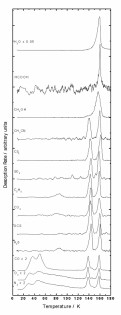The Heriot-Watt Astrochemistry Research Group |
 |
Survey of the thermal desorption of astrophysically relevant molecules
The CO-like molecules include N2, O2, CH4 and CO. When these species were deposited as pure ices they showed two peaks in their TPD traces, corresponding to multilayer and monolayer desorption. When these species are deposited on top of water the multilayer peak is absent. There are desorption features at 20-60 K, but the lower temperature peak occurs at too high a temperature to be desorption of the multilayer. The water-like molecules include ammonia and methanol. When desorbing from the gold, they both show only one peak corresponding to multilayer desorption, indicating that each molecule is bound more strongly to its neighbour in the film than to the gold surface. Multilayer desorption peaks are also observed when these species desorb from a water ice film. Unlike the CO-like species, the ammonia and methanol can not diffuse into the water ice layer, so the solid film that is initially deposited stays in place until heating. The methanol shows a second peak which is coincident with the water desorption. This is from the monolayer of methanol directly bound to the surface of the water ice and indicates that the methanol is bound more strongly to the water than to the other methanol molecules in the film.
The intermediate species include H2S, OCS, CO2, C2H2, SO2, CS2, and CH3CN and display behaviour in between that of the CO-like and water-like molecules. Desorption traces of the pure solids show a single desorption feature, as do water-like molecules. When the molecules are deposited on top of a layer of water ice, the TPD traces show both multilayer desorption and molecular volcano desorption as a result of trapping. The intermediate species can diffuse into the porous water layer, but not to the same extent as the CO-like molecules.

Click on image to open a larger version in a new window
This research is included in the following publication:
M. P. Collings, M. A. Anderson, R. Chen, J. W. Dever, S. Viti, D. A. Williams and M. R. S. McCoustra
Monthly Notices of the Royal Astronomical Society,